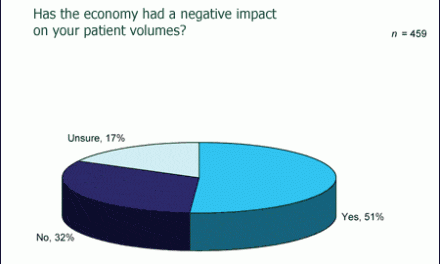Sleep Review interviews Prof Dr Georg Dorffner, CEO, of The Siesta Group, and Joe Smith, RRT-NPS, respiratory clinical manager for Invacare Corp

An automated scoring system should provide robust and valid results, a quality standard comparable with a human expert scorer, and transparency, says Prof Dr Georg Dorffner, CEO of The Siesta Group, Vienna, Austria. Dorffner says The Siesta Group’s Somnolyzer 24×7 provides all those features. Sleep Review spoke with Dorffner to find out more.
What are the pros and cons of using an automated scoring system?
It can help you save time and money and ensures that your scorings are of constant quality. Due to the well-known variability that different experts have among each other, this cannot be guaranteed today. Scorings made at different labs or at different points in time can considerably differ from each other.
How does the Somnolyzer differ from other automated scoring systems?
As opposed to other automatic scoring programs, Somnolyzer 24×7 has a proven performance that makes it indistinguishable from a human expert. It was developed and tested on the largest normative database on healthy and disturbed sleep available worldwide. Given the known large inter-rater variability of human scorers, achieving “100% correct” scoring is impossible. Instead, Somnolyzer 24×7 has been proven to have the same performance as any human expert when compared to other experts. Somnolyzer 24×7 applies the same rules as any human expert. It first reliably detects all relevant visual features, such as spindles, eye movements, and delta waves, and then discriminates between the stages according to what is present in each epoch. Somnolyzer 24×7 is thus not a black box but can provide transparent answers as to how it has reached a result.
To prevent failure—if the recording is distorted or contains unexpected or unusual events—we filter data for possible error sources and check the results before sending them to you. In some cases, visual correction might be necessary and will be performed by us. In very rare cases, the recording will have to be returned unscored. Whenever you get a result, however, you can rely on it being a hypnogram you can trust in your diagnosis.
Somnolyzer 24×7 also provides the Siesta Spot Report. This is a comparison of the calculated hypnogram with the hypnograms in the normative data base of healthy sleep. Depending on age and gender of the patient, the most important parameters of the sleep profile are compared to the norm.
Why does Somnolyzer not run on the user’s own computer?
For three good reasons: 1) By running Somnolyzer 24×7 at a central site, we can assure you of the workings of our quality control. As said above, automatic analysis can sometimes go wrong, but we can still guarantee that you can rely on the results you are getting. 2) Somnolyzer 24×7 will continuously improve in terms of handling more cases fully automatically (ie, without visual checks or corrections) and thus become quicker. For this, seeing data from many different labs is crucial. 3) The Siesta Spot Report is based on the largest normative database, which will become even larger over time.

A CPAP unit can be effective and compliance-promoting, but if it is not profitable for dealers, end users may never see it. This presents manufacturers with a challenge: developing CPAP products that can monitor and improve patient compliance while remaining within reimbursement constraints. Sleep Review spoke about this issue with Joe Smith, RRT-NPS, respiratory clinical manager for Invacare Corp, Elyria, Ohio.
What are the latest trends in the sleep market, and what has influenced these trends?
There continues to be a downward trend in CPAP and bilevel reimbursement, and in light of the pending oxygen reimbursement cuts from Medicare, dealers will be forced to look closely at their current service models. The clinical component of CPAP and bilevel therapy is one of the most costly areas in the delivery of those products. We are starting to see new delivery models that are driven by reimbursement. Presently, there are providers mailing CPAP units to patients with instruction material, rather than using a clinician to provide the initial setup. In this model, clinical assistance is made available at a patient’s request, thereby reducing costs. Other service models require patients to come in to the provider’s office to a “sleep fitting room.” This allows one clinician to service many more patients than they could in a traditional delivery model, where a home care practitioner visits patients in their homes.
We also are anticipating some shifts in the area of sleep diagnostics. Recently, CMS invited comments on the modification of coverage guidelines to allow home testing for the evaluation of OSA. The technology is there for portable/unattended home studies; the challenge will be in establishing a protocol to determine which patients are appropriate for home studies.
How is Invacare planning on responding to those trends?
Our focus will be on offering equipment that provides effective treatment for patients and profitability for dealers. One of the biggest concerns for both patients and providers is compliance. Patients want to be compliant with their therapy, and dealers are being asked to provide compliance information to physicians/sleep laboratories. The challenge is to provide a product that does both without driving up the costs associated with new technology. Our first major stab at this challenge is our Polaris™ EX™ CPAP with SoftX™. The Polaris EX is focused on patient comfort by reducing expiratory discomfort. It also provides real-time compliance information in a quick, simple, and inexpensive way.
We also are evaluating current technologies for ambulatory/home diagnostics and how these devices may fit into our overall sleep business plan.
Where do you see that market going in the future?
Again, in-home or some form of remote, nontraditional studies seem to be on the horizon. In conjunction with this, the use of auto-titrating or “smart CPAPs” may be gaining popularity. Compliance monitoring will become a very controversial topic. With shrinking reimbursement, determinations will have to be made on how and when we monitor compliance and who is responsible.





